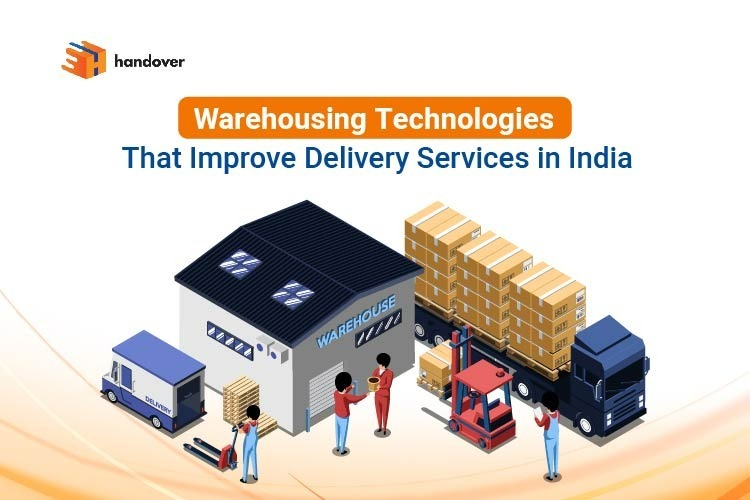Handover news
Blog
Warehousing Technologies That Improve Delivery Services in India

Warehouses are important in the context of effective logistics services in India. Effective warehousing leads to on-time and reliable product supplies to retailers and end consumers. Now as demand surges for fast delivery services in Noida, Delhi, Mumbai, Bangalore, Pune and other locations across India, the need for technology-powered warehouses is on the rise. Advanced automation technologies help warehouses align with production volumes and consumer demand. These technologies make warehouses smart in the truest sense. Smart warehouses offer enhanced productivity, accuracy and efficiency. Let’s learn about such technologies below.
Reasons That Call for Warehouse Automation
Besides reducing human error, reducing the injury risk and ensuring throughput optimisation, automation decreases your overheads, enhances operational flexibility, and lets you be more accurate while assessing workforce requirements.
Top Warehouse Technologies
Warehouses must come equipped with smart technologies to live up to high delivery service expectations. In today’s times, emerging needs arise. To meet the same, warehouses will have to be technology-oriented. Here’s a list of technologies that empower warehouses across India.
Warehouse Management System
A warehouse management system should involve integrating your entire warehouse data into a platform that is easy to access. Doing so allows select members of your supply chain a comprehensive view of operations, reporting, accurate planning potentials, and real-time statistics. Your warehouse management system should complement other autonomous processes and ensure the following –
- Access to real-time visibility into the supply chain
- Perfect Demand Forecasting
- Decreased Labour Costs
- Streamlined Warehouse Functions
- Optimised Layout of Warehouses
- Improved Inventory Management
- Enhanced Pick Precision
- Reduced Time Between Inventory Pickups
- Enhanced Flexibility and Responsiveness of Warehouses
- Enhanced Safety and Security of Warehouses
- Boosts Supplier Relationships
- Improves Customer Service Levels
Multi-user Warehousing
With more customers seeking product deliveries, warehouses are increasingly multi-user focused. What it does is split labour and operational costs among all users, helping the company reduce expenses on the same. It helps manufacturers sign shorter contracts with warehouse owners as opposed to earlier times of single-user warehousing with multiple-year leases.
Increasing Adoption of Verticalisation in Storage
Warehouses across large cities and metros face elevated real estate costs. With robust demand for delivery services comes the need for increased space. Ensuring vertical storage using racks and vertical carousels can help create that space. This helps build economies of scale. Warehouse owners feel the need to upskill their workforce to ensure a seamless experience for all the parties involved.
Increased Wave of E-commerce
Customers are increasingly purchasing via e-commerce platforms. Warehouses would thus need to adjust to multi-channel inventory management. They also need to manage B2C and B2B inventory, hence playing a pivotal role in boosting relationships between retailers and wholesalers. Warehouses deliver large inventories to one or a few locations for B2B clients. Whereas with retail e-commerce, warehouse owners can easily deliver smaller shipments to a large number of people. With the advent of same-day delivery mechanisms, the need for hyperlocal delivery services in India. As a result, warehouses seek suitable management systems for complex picking and delivery patterns.
Energy Consumption Optimisation
Energy usage optimisation becomes important in the wake of increasing energy costs eating into margins. Modernising traditional equipment, despite involving a large investment upfront, can help optimise energy and ensure enhanced operational efficiency. Warehouses are increasingly using sustainable solutions such as roof-top solar panels.
Adoption of IoT and AI
Smart warehouses will have sensors everywhere to help process control systems evaluate different processes and identify potential fluctuations. There will be set parameters for each process. In case of deviation in any of these, warehouse operators can identify and correct the same. Warehouse operations involve extensive video analytics to monitor the flow and behaviour of the workforce and machines. These analytics can help implement safety measures in the warehouse to prevent activities such as loitering in restricted areas, measure the flow of people across certain warehouse areas at specified times, and help ensure smooth operations.
Wrapping Up
Warehouses are key to mobilising India to greater heights in times to come. So, they must continue to embrace advanced technologies to ensure seamless delivery services across the country. As a business enterprise, you can contact handover (handover Karo, Khush Raho) for delivery services. It is a leading logistics company with an extended fleet of 2-wheelers, 3-wheelers, trucks, etc. Embrace the new-age delivery revolution with handover.
